
Ragweeds are flowering plants in the genus Ambrosia in the aster family, Asteraceae. They are distributed in the tropical and subtropical regions of the Americas, especially North America, where the origin and center of diversity of the genus are in the southwestern United States and northwestern Mexico. Several species have been introduced to the Old World and some have naturalized and have become invasive species. Ragweed species are expected to continue spreading across Europe in the near future in response to ongoing climate change.

Ambrosia dumosa, the burro-weed or white bursage, a North American species of plants in the sunflower family. It is a common constituent of the creosote-bush scrub community throughout the Mojave desert of California, Nevada, and Utah and the Sonoran Desert of Arizona and northwestern Mexico.

Ambrosia trifida, the giant ragweed, is a species of flowering plant in the sunflower family. It is native to North America, where it is widespread in Canada, the United States, and northern Mexico.
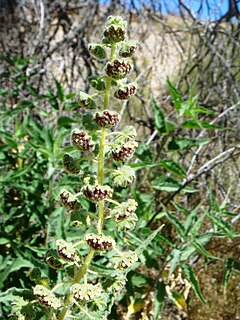
Ambrosia ambrosioides, also known as canyon ragweed or chicura, is a ragweed found in the deserts of northern Mexico, Arizona, and California.

Ambrosia acanthicarpa is a North American species of bristly annual plants in the sunflower family. Members of the genus Ambrosia are called ragweeds. The species has common names including flatspine bur ragweed, Hooker's bur-ragweed, annual burrweed, annual bur-sage, and western sand-bur. The plant is common across much of the western United States and in the Prairie Provinces of Canada.
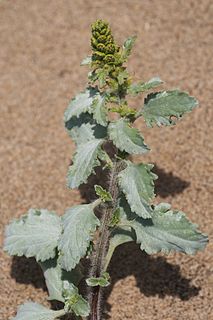
Ambrosia chamissonis is a species of ragweed known by the common names silver burr ragweed, silver beachweed and (silver) beach bur(r).

Ambrosia psilostachya is a species of ragweed known by the common names Cuman ragweed and perennial ragweed, and western ragweed.

Ambrosia chenopodiifolia is a species of ragweed known by the common names San Diego bursage and San Diego bur ragweed. It is native to the Mexican states of Baja California and Baja California Sur, as well as to Orange and San Diego Counties it int US State of California. It is a member of the coastal sage scrub plant community.

Ambrosia confertiflora is a North American species of ragweed known by the common name weakleaf bur ragweed.

Ambrosia eriocentra is a North American species of ragweed known by the common names woolly bursage and woollyfruit burr ragweed.
Ambrosia ilicifolia is a species of ragweed known by the common names hollyleaf burr ragweed and hollyleaf bursage.

Ambrosia pumila is a rare species of herbaceous perennial plant known by the common names San Diego ragweed and San Diego ambrosia. It is native to far southern California, Baja California, and Baja California Sur. It grows in floodplains and open grasslands in proximity to wetland areas.
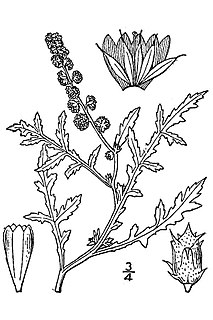
Ambrosia tomentosa, the skeletonleaf bur ragweed, silverleaf povertyweed, or skeleton-leaf bursage, is a North American species of perennial plants in the.
Ambrosia cheiranthifolia is a rare species of flowering plant known by the common names South Texas ambrosia and Rio Grande ragweed. It is native to the coast of South Texas and the Mexican states of Tamaulipas and Coahuila. It occurs in coastal prairie, grassland, and mesquite shrubland habitat. It has declined because its native habitat has been cleared for development, with remaining open savanna invaded by non-native grasses such as buffelgrass. Today there are perhaps 20 populations remaining, but some of these may have very few genetic individuals because the species is clonal, with many cloned plants attached by one rhizome. It is not certain that the plant still exists in Mexico. This is a federally listed endangered species of the United States.
Ambrosia deltoidea is a North American species of flowering plant in the aster family known by the common names triangle bur ragweed, triangle bursage, and triangleleaf bursage.
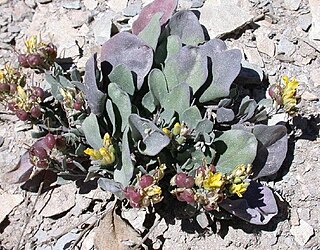
Physaria pruinosa is a species of flowering plant in the family Brassicaceae known by the common names Pagosa Springs bladderpod and frosty bladderpod. It is native to Colorado and New Mexico in the United States.

Ambrosia salsola, commonly called cheesebush, winged ragweed, burrobush, white burrobrush, and desert pearl, is a species of perennial shrub in the sunflower family native to deserts of the southwestern United States and northwestern Mexico.
Ambrosia grayi, the woollyleaf bur ragweed, is a North American species of plants in the sunflower family. It is native to the west-central part of the Great Plains of the United States, in the states of Nebraska, Kansas, Colorado, New Mexico, Oklahoma, and Texas.
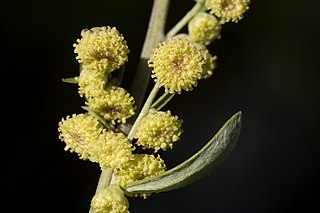
Artemisia franserioides, the ragweed sagebrush or bursage mugwort, is a North American species of plants in the sunflower family. It is native to the southwestern United States as well as northern Mexico (Chihuahua).

Amauriopsis dissecta is a North American species of flowering plants in the daisy family known by the common names yellow ragweed and ragleaf bahia. It is native to the western United States as far north as the Black Hills of South Dakota and Wyoming, as well as in northern Mexico.















